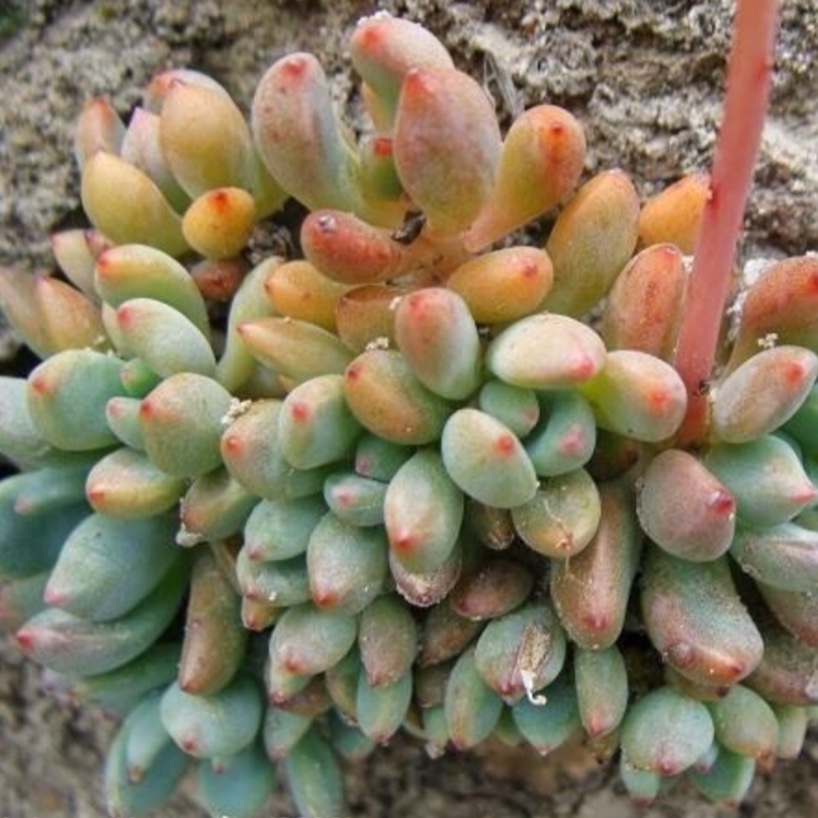
Echeveria Amoena
Echeveria 'Amoena'
Series Paniculatae Type : Not designated. Neotype (Iconotype) Fig. 30 Echeveria pusilla in Gartenflora, 53: 206, 1904. Etymology : Latin adjective amoenus = beautiful, pleasing. Distribution Mexico (Morelos, Puebla, Veracruz). English description by Britton & Rose (in North American Flora, 22: 26, 1905) : Acaulescent or nearly so, with numerous short offsets, pinkish-pruinose. Leaves in small but dense rosettes, 2 cm long or less, 6 - 8 mm wide, thick, spatulate-oblanceolate, acute. Flowering branches slender, ascending, 10 - 20 cm long, their tips drooping at anthesis, their leaves oblong to oblanceolate, 1 cm long or less, blunt, readily falling away; flowers 1 - 8; pedicels slender, 1 - 2 cm long. Calyx-lobes orbicular, about 1.5 mm broad, appressed to the base of the corolla; corolla coral-red, 8 - 10 mm long, 4 mm thick, the lobes twice as long as the tube, their tips somewhat spreading, acute.
Contributed by @gardentagssucculentexpert
-
Full sun to partial shade
-
Occasional watering
-
A little frost hardy: 32F (0°C)
-
Free draining and fertile
Common name
Echeveria 'Amoena'
Latin name
Echeveria Amoena
type
Succulent
family
Crassulaceae
ph
5.5 - 6.0 Acid - Neutral
Plant & bloom calendar
-
Best time to plant
-
When the plant will bloom
full grown dimensions
 0.15 M
0.10 M
0.15 M
0.10 M
Echeveria Amoena
Series Paniculatae Type : Not designated. Neotype (Iconotype) Fig. 30 Echeveria pusilla in Gartenflora, 53: 206, 1904. Etymology : Latin adjective amoenus = beautiful, pleasing. Distribution Mexico (Morelos, Puebla, Veracruz). English description by Britton & Rose (in North American Flora, 22: 26, 1905) : Acaulescent or nearly so, with numerous short offsets, pinkish-pruinose. Leaves in small but dense rosettes, 2 cm long or less, 6 - 8 mm wide, thick, spatulate-oblanceolate, acute. Flowering branches slender, ascending, 10 - 20 cm long, their tips drooping at anthesis, their leaves oblong to oblanceolate, 1 cm long or less, blunt, readily falling away; flowers 1 - 8; pedicels slender, 1 - 2 cm long. Calyx-lobes orbicular, about 1.5 mm broad, appressed to the base of the corolla; corolla coral-red, 8 - 10 mm long, 4 mm thick, the lobes twice as long as the tube, their tips somewhat spreading, acute.
Planting
From Early Spring TO Late Winter
Echeveria can be propagated easily by separating pups, but also by leaf cuttings, and by seed. It needs a warm, sunny position with well drained soil to develop their foliage colour. It is recommended to position plants in an area where they are in part shade. This means that they should be in morning sun, or afternoon sun, or both (but shaded during the harsh midday period). Alternatively, plants may be grown under full filtered sun underneath shade cloth which is usually stocked by your local hardware store. 50% filtration is recommended to avoid sunburn but maintain great colour. You may need to test what works well in your particular climate. Most succulents will be grown in containers and pots and they will need good drainage medium. Add coarse grit such as perlite or pumice to soil and repot every year in late-spring. Don't worry about damaging the roots when re-potting as most Echeveria generally tolerate disturbance well.
Flowering
From Early Spring TO Late Winter
Echeveria could flower a number of times through the year. Flowering can use much of the plant’s energy, therefore it’s recommended that flower stalks are removed from sick or weaker plants until they are well established. If your plant is healthy, enjoy it’s beautiful show of blooms. Flowers on short stalks (cymes) arise from compact rosettes of succulent's fleshy, often brightly coloured leaves. Species are polycarpic, meaning that they may flower and set seed many times over the course of their lifetimes and indeed a number of times per year.
Propagating
From Early Spring TO Late Winter
Pluck a leaf gently from the stem taking care not to damage the leaf. It should have a u-shape if plucked correctly. Leave the leaf for a few days to callous over. Once this has happened, place the leaf on top of your propagation medium of choice with the u-shaped end downward, rest the leaf on a bamboo stick or similar at a 45 degree angle to the propagation medium. Propagation is best done in indirect light, not in direct sunlight. Alternatively, a grow light can be used. Roots should sprout in two to four weeks, followed by new tiny leaves. At this point, depending on the humidity and rainfall in your area, you may mist or lightly water your leaves as the plant grows. Resist the urge to remove the mother leaf once it becomes dried up and shrivelled. It’s best for this process to occur naturally.



















